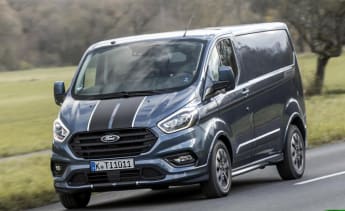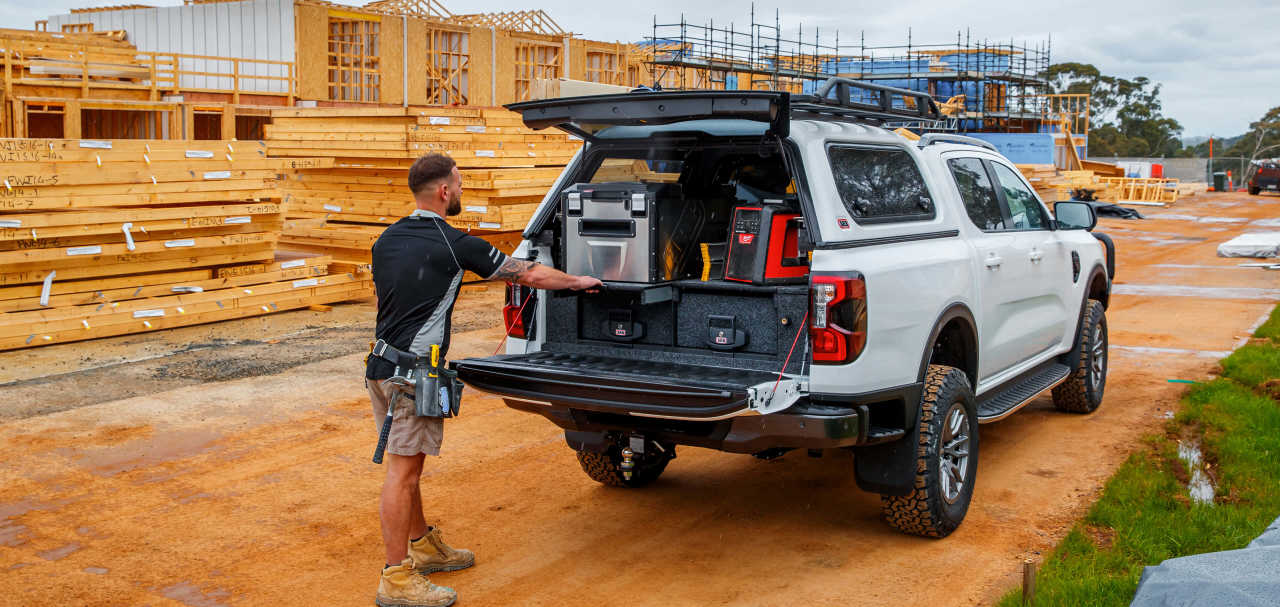Those looking to buy a mid-sized (2.5 to 3.5-tonne GVM) commercial van are spoilt for choice, as there are currently 11 models from nine manufacturers competing for your business.
Latest VFACTS industry figures show that Toyota’s HiAce continues to dominate this segment with a staggering 46 per cent share of sales, well ahead of Hyundai’s Staria Load, LDV’s G10 and Ford’s Transit Custom in a close three-way fight for second place.
Chasing a larger slice of this pie chart, Ford has launched its all-new Transit Custom range which in Australia is the first new generation of Transit Custom in a decade.
Ford claims it’s globally popular one-tonner has been redesigned from the ground up, so we recently spent a week aboard to see from a tradie's perspective if it has what it takes to put a larger dent in HiAce sales.
Ford Transit Custom 2024: Trend (Lwb)
| Engine Type | Diesel Turbo 4, 2.0L |
|---|---|
| Fuel Type | Diesel |
| Fuel Efficiency | 7.6L/100km (combined) |
| Seating | 3 |
| Price From | $48,290 - $55,550 |
Does it represent good value for the price? What features does it come with? 8/10
8 / 10
The new Transit Custom range consists of four models, comprising the work-focused Trend in a choice of short wheelbase (SWB) or long wheelbase (LWB) plus the more lifestyle-oriented Sport SWB and Sport Double-Cab LWB.
Our test vehicle is the Trend LWB, which like all variants is available only with Ford’s latest 2.0-litre TDCi EcoBlue four-cylinder turbo-diesel and eight-speed automatic for a list price of $57,590. That's considerably higher than rivals including the Toyota HiAce LWB Barn Door ($51,636), Hyundai Staria Load Barn Door ($46,740) and LDV G10+ Barn Door ($39,537).
.jpg)
It comes standard with Frozen White paint, 16-inch steel wheels with replaceable plastic covers and 215/65R16C tyres with a full-size steel spare.
There's fabric-trimmed seating for three comprising an eight-way manually adjustable driver’s seat, with lumbar support and fold-down inboard armrest, plus a two-passenger bench seat. The two outer seating positions are also heated.
The cabin is separated from the cargo bay by a metal bulkhead which doubles as a cargo barrier, equipped with a central window and load-through hatch (see Practicality). Plus there’s keyless start, USB-A/USB-C ports and a 12-volt socket, Sensico (synthetic leather) steering wheel with ample height/reach adjustment and more.
.jpg)
The dash offers a big 12-inch screen with 7.0-inch colour digital instrument cluster for the driver, plus a 13-inch multi-function colour touchscreen display which controls some vehicle settings and the four-speaker SYNC 4 multimedia system with digital radio, Bluetooth and wireless Apple CarPlay and Android Auto compatibility.
There’s also wireless phone charging, sat-nav and, for the first time in a Ford vehicle in Australia, an embedded 5G modem to optimise connectivity.
.jpg)
Is there anything interesting about its design? 8/10
8 / 10
Our Trend LWB test vehicle has a 3500mm wheelbase and 5450mm overall length, with both dimensions being 400mm longer than its SWB sibling. Its 1980mm height ensures access to height-restricted areas like multi-storey carparks and underground loading bays.
The new front-wheel-drive chassis platform retains simple and rugged MacPherson struts up front, but there’s a new coil-spring independent rear suspension (IRS) replacing the previous leaf-spring/beam axle for improved ride comfort and handling. Steering is rack and pinion and there’s a quartet of disc brakes.
Its new cargo bay design has a lower floor and new access step for improved ease of loading and unloading. The front wheels and strut towers have also been moved further forward, resulting in a shorter front body overhang to assist when parking and manoeuvring in confined spaces.
.jpg)
This front suspension relocation has also improved cabin floor space and foot rests for occupants, in a user-friendly cabin that allows a driver to easily enter and exit the vehicle from both sides. This ‘walk-through’ function is enabled by a flat floor combined with a flush-fitting electronic parking brake button and column-mounted gearshift stalk to ensure the dash is largely free from protrusions.
The steering wheel is noticeably square in shape, which offers two benefits. The squared-off bottom half optimises space for the driver’s torso, while the top half creates a ‘frame’ around the instrument panel to provide the driver with an unobstructed view.
Our only gripe was a loose plastic moulding that shrouds the wiper motor on the RHS rear barn-door. On numerous occasions, after clicking it back in place, it would become dislodged when closing the doors and tumble into the cargo bay. It could have been a manufacturing fault unique to our test vehicle, but not something we've previously experienced in Transit Customs.
.jpg)

How practical is its space and tech inside? 9/10
9 / 10
With its 2016kg minimum kerb weight and 3225kg GVM, the Trend LWB offers a one-tonne-plus payload rating of 1209kg. It also has a big 2500kg braked tow rating and with its generous 5725kg GCM (or how much it can legally carry and tow at the same time) it impressively can tow its maximum trailer weight while hauling its maximum payload.
The cargo bay is accessed via a standard kerbside sliding-door with large 1030mm opening, plus rear barn-doors that open to 180 degrees. Note our test vehicle has the extra-cost option of sliding-doors on both sides (an optional single-lift tailgate is also available).
The LWB load floor is 3002mm long with 1392mm between the rear wheel-housings. So, it can comfortably carry up to two standard Aussie pallets or up to three Euro pallets, held in place by a choice of eight load-anchorage points.
.jpg)
By opening the hatch at the base of the cabin bulkhead, the floor length extends to 3450mm by utilising spare room under the passenger bench seat. This feature is handy for carrying long lengths of timber, electrical conduit, copper/PVC pipe, rolls of carpet etc.
Its 6.8 cubic metres of load volume is larger than the HiAce LWB’s 6.2 and the cargo bay comes standard with Ford’s ‘Load Area Protection Kit’ comprising a moulded floor-liner plus side and rear door protection. Three internal LED lights provide brilliant illumination in low-light conditions.
Although not fitted to our test vehicle, all MY24.5 models come equipped with Ford’s clever integrated roof-rack system, comprising a trio of hinged racks which lie flat when not in use but can be easily raised and locked into vertical positions. This sturdy design can carry up to 155kg when shared across the three racks.
.jpg)
There’s generous cabin storage too, with each front door offering three tiers of storage with the largest central tier comprising a large-bottle holder and bin.
There’s also small-bottle/cup-holders at each end of the dash and a fold-out small-bottle/cup-holder for the driver lower down, plus a glovebox and on top of the dash two cavernous compartments which negate the need for an overhead shelf.
The centre seat’s backrest folds flat to reveal a small work desk and the bench seat’s hinged base-cushions can tilt forward into a vertical position to access a large hidden storage area beneath. This vast space also serves as the cargo bay’s load-floor extension when carrying long items.
What are the key stats for its engine and transmission? 8/10
8 / 10
Ford’s latest TDCi EcoBlue 2.0-litre four-cylinder turbo-diesel with AdBlue produces the same 125kW at 3500rpm as its predecessor. It also matches the previous model’s 390Nm of torque, but it's served across a wider torque band between 1750-2500rpm which is also higher in the rpm range.
The new eight-speed torque converter automatic (previously six-speed) is smooth and refined, offering the choice of sequential manual-shifting via a rotating knob on the column-mounted gearshift stalk. There are also four selectable drive modes comprising Normal, Eco, Slippery and Tow/Haul.
.jpg)
What is its fuel consumption? What is its driving range? 8/10
8 / 10
Ford claims an official combined average of 8.0L/100km and the dash display was claiming a close 8.9 at the completion of our 273km test.
This was mostly unladen city and suburban driving, plus hauling a near-maximum payload on a mix of highways and backroads. The engine’s Auto Stop/Start feature remained on for the duration of our test.
Our own figure, calculated from fuel bowser and tripmeter readings, was higher again at 9.2 which is still excellent single-digit economy for a van weighing more than two tonnes in real-world use. Therefore, based on our figure, you could expect a realistic driving range of around 760km from its 70-litre tank.
.jpg)
What’s it like to drive? 9/10
9 / 10
The large front doors open wide for easy access. Multiple seat adjustments combined with a fold-down inboard armrest, ample choice of steering wheel height/reach and a large left footrest ensure a comfortable driving position.
The thick-rimmed steering wheel has a quality feel and there’s clear eyelines to the big door mirrors, in which the lower third of each offers a wide-angle view. This is most appreciated on the LHS given the van’s solid walls and resulting huge blind-spot, with safety enhanced by blind-spot monitoring and cross-traffic alert.
It has brisk acceleration from standing starts, with the eight-speed automatic smoothly upshifting at 2500rpm in each gear to keep the engine operating in its peak torque zone. This ensures zippy performance in city and suburban driving, plus optimum efficiency at highway speeds.
Unladen ride quality and handling are enhanced by the new IRS, although the difference is not as noticeable as you might expect given how well Ford refined the previous leaf-spring/beam axle arrangement.
.jpg)
To test its payload rating we forklifted 975kg into the cargo bay, which combined with our crew of two equalled a total payload of 1155kg that was only 54kg less than its legal limit.
The coil-spring IRS compressed about 60mm under this load, which ensured long cone-shaped jounce rubbers attached to the underfloor engaged with the suspension arms to provided a second stage of load support. This also avoided any harsh bottoming-out over larger bumps on our test route.
Its competent drivetrain also made light work of our 13 per cent gradient, 2.0km-long set climb at 60km/h, with the eight-speed auto self-shifting down to fifth gear and maximum torque at 2500rpm to easily haul this load to the summit.
Engine braking on the way down was also commendable, given its modest 2.0-litre displacement and the big payload it was trying to restrain, with only one solid brake application required to avoid exceeding the speed limit or reaching its 5000rpm redline on overrun.
Warranty & Safety Rating
What safety equipment is fitted? What safety rating? 7/10
7 / 10
No ANCAP rating as yet but it offers numerous firsts including a roof-mounted airbag for the passenger which enables the expansive top-of-dash storage. There’s also an exit warning system for the driver, which uses the vehicle’s rear sensors to play an audible alert when an object (such as a bicycle) is approaching while the door is being opened.
The safety menu also includes adaptive cruise control, pre-collision assist with auto emergency braking (AEB) and intersection assist, reverse brake assist, lane-keeping assist, speed sign recognition, parking sensors, tyre pressure monitoring, rear-view camera with 180-degree split-view and lots more.
.jpg)
What warranty is offered? What are its service intervals? What are its running costs? 8/10
8 / 10
The Transit Custom is offered with a five-year/unlimited km warranty. Scheduled service intervals are 12 months/30,000km, whichever occurs first. Capped-price servicing of $499 applies to each of the first four scheduled services across four years/120,000km.
Verdict
Although yet to be ANCAP-rated, the latest Transit Custom LWB offers numerous design features unmatched by the dominant HiAce LWB, along with higher load volume/payload/tow ratings and less frequent servicing. However, those attributes come at a much higher price than its Toyota rival, so only a potential buyer can decide if they’re worth the extra spend.
Pricing Guides







.jpg)
.jpg)




.png)


.jpg)
.jpg)



.jpg)
